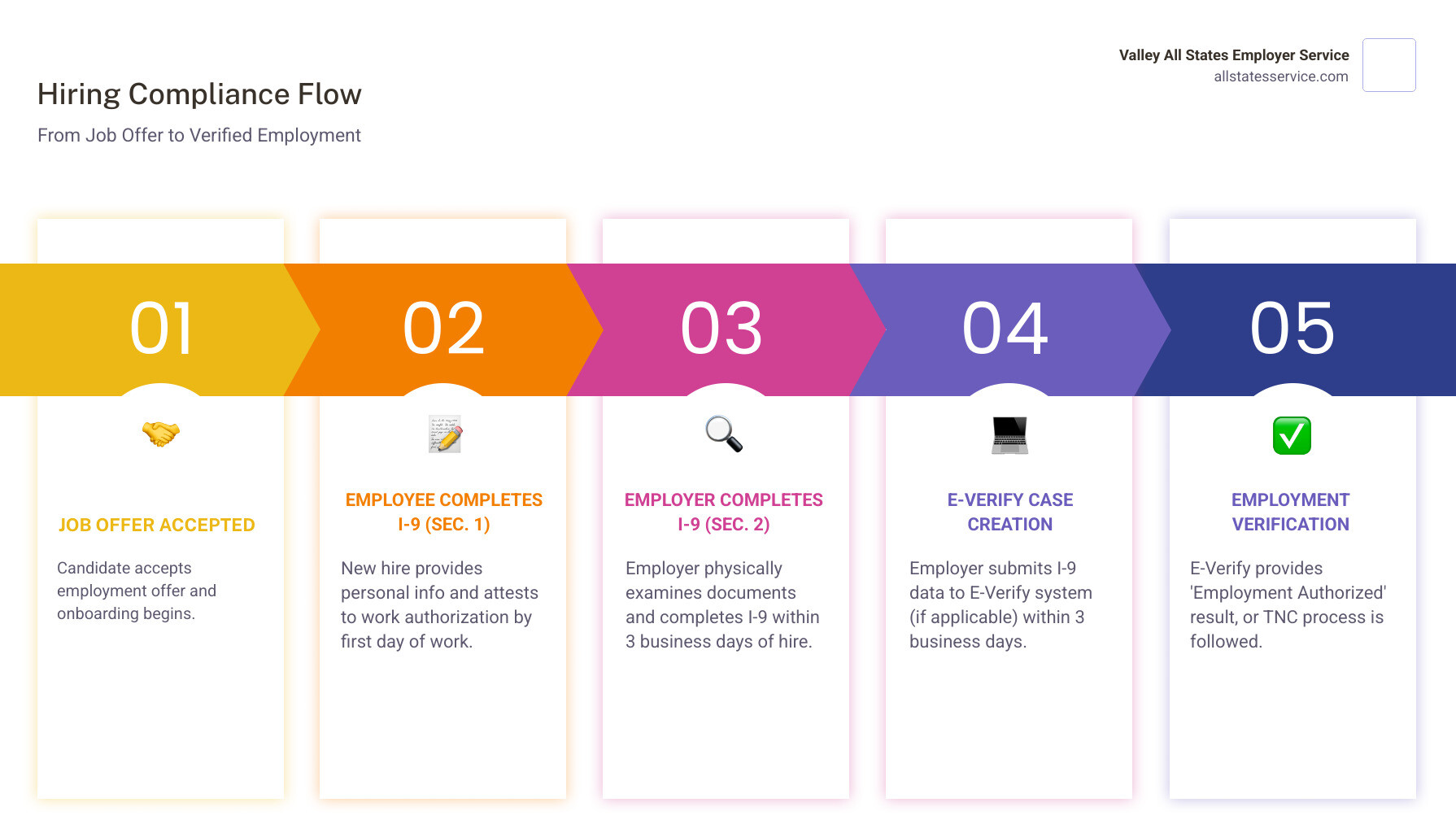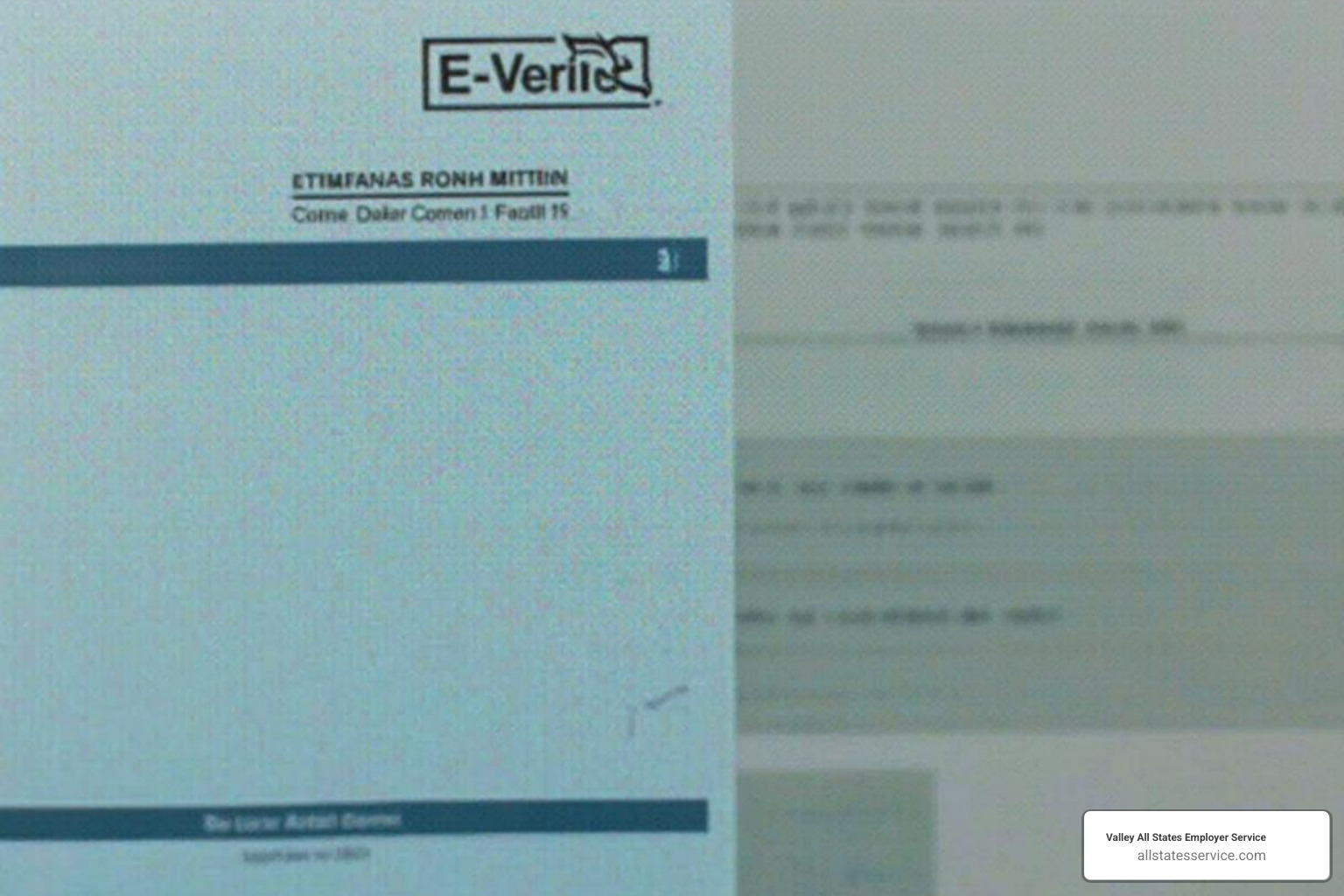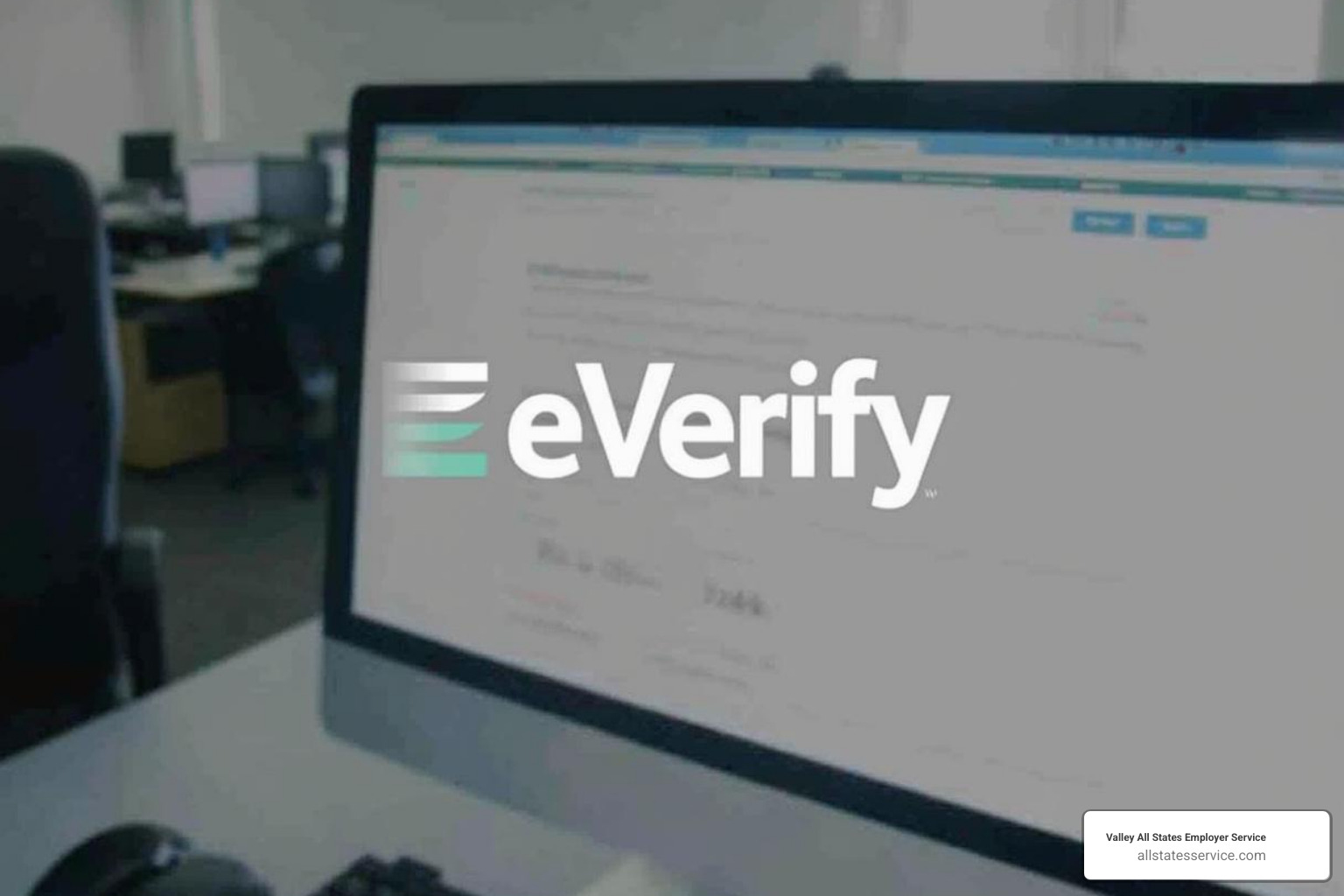Your Guide to Employment Verification
When you hear E-Verify and I-9, you’re likely thinking about hiring paperwork. And you’d be right! These are key parts of making sure your team is legally authorized to work in the U.S. But what exactly are they?
- Form I-9, Employment Eligibility Verification: This is a document all U.S. employers must complete for every new hire. It’s how you confirm an employee’s identity and their legal right to work.
- E-Verify: This is an online system. It’s run by the Department of Homeland Security (DHS) and works with the Social Security Administration (SSA). E-Verify checks the information from an employee’s I-9 against government records. This makes sure their work authorization is accurate.
- Primary Purpose: Both tools serve one main goal: to help employers maintain a legal workforce in the United States.
For busy HR managers, these processes can seem complex. But understanding them is vital for smooth onboarding and avoiding legal headaches. This guide will walk you through everything you need to know. We’ll cover the responsibilities for both you and your new hires. Did you know nearly 3 million proactive worksites already use E-Verify? It’s a powerful tool for compliance.

The Foundation: Getting Form I-9 Right Every Time
So, you’ve found the perfect new team member. Congratulations! Now comes the important part: making sure all the hiring paperwork is in order. At the heart of this is Form I-9, the cornerstone of employment eligibility verification in the United States. Think of it as the official welcoming document that confirms your new hire’s identity and their legal right to work here. It’s a critical step in maintaining a compliant workforce, stemming from the Immigration Reform and Control Act (IRCA) of 1986. This law made it clear: employers must not knowingly hire individuals unauthorized to work in the U.S.
As an employer, you have clear responsibilities when it comes to completing Form I-9. First, your new employee needs to fill out Section 1. This is where they provide their personal details and confirm their work authorization status. They should complete this no later than their very first day of work for pay. A little tip: they can actually fill this out after accepting the job offer but before their first official day, which can really help streamline your onboarding process!
Next, it’s your turn. You’ll complete Section 2, the employer section, within three business days of the employee’s first day of work for pay. This is often called the “three-day rule.” During this crucial period, you’ll examine the original documents your employee presents. These documents are proof of both their identity and their authorization to work.

The U.S. Citizenship and Immigration Services (USCIS) provides the official Form I-9 and offers an incredibly helpful guide, the M-274, Handbook for Employers. These are invaluable resources for navigating all the details of employment eligibility.
Acceptable Documents for Form I-9
When it comes to proving identity and work authorization, employees get to choose which documents to present from an official list. This list is divided into three clear categories:
- List A documents: These are the superstars because they establish both identity and employment authorization. Think of documents like a U.S. Passport or a Permanent Resident Card (often called a Green Card). If your employee presents a List A document, that’s all you need!
- List B documents: These documents establish identity only. Common examples include a state driver’s license or a state ID card.
- List C documents: These establish employment authorization only. You’ll frequently see documents like an unrestricted Social Security card or an Employment Authorization Document (EAD) in this category.
If an employee provides a List B document, they must also provide a List C document. You can’t tell an employee which specific documents they must bring; they have the right to choose from the acceptable lists provided by the government.
Once your Form I-9 is completed, retain it for a specific period. If an employee worked for less than two years, you must keep their form for three years after their hire date. If they worked for more than two years, you’ll retain it for one year after their employment termination date. Proper I-9 storage is crucial for compliance. We always recommend secure, organized systems, whether you prefer paper or digital files. This ensures easy retrieval if needed. For more detailed guidance and hands-on help with this complex area, our team offers specialized I-9 Verification Assistance.
The Digital Check: What is E-Verify?
We’ve talked about the Form I-9 as the vital first step in verifying employment. Now, let’s explore E-Verify, which takes that process into the digital age. Think of E-Verify as a powerful online tool that gives your employment verification an extra layer of security and certainty. It’s an internet-based system that helps employers like you electronically confirm if your new hires are truly authorized to work in the United States.
So, how does E-Verify work its magic? It does this by comparing the information from your employee’s Form I-9 against official government records. Specifically, it checks against databases from the Department of Homeland Security (DHS) and the Social Security Administration (SSA). This digital cross-check is designed to be quick, free, and incredibly effective at reducing unauthorized employment.

Here’s the simple flow: Once your employee completes their Form I-9, you’ll take key details from it and enter them into the E-Verify system. Almost instantly, E-Verify processes that information. Within seconds, it usually tells you if the employee is employment authorized. Sometimes, it might flag a Tentative Nonconfirmation (TNC), meaning there’s a mismatch. Don’t worry, we’ll dive into what to do about TNCs a bit later in this guide!
Now, for a common question: Is E-Verify mandatory for all employers? The straightforward answer is, “not always,” but there are some big exceptions. For most businesses, E-Verify is a voluntary program. However, if you’re a federal contractor and your contract includes the Federal Acquisition Regulation (FAR) E-Verify clause, then it is mandatory for your new hires and often for existing employees working on those federal contracts.
Beyond federal rules, many states have also stepped in. Depending on where your business operates, E-Verify might be a requirement. Some states make it mandatory for nearly all private businesses, state agencies, or once a company reaches a certain number of employees. For example, states like Arizona and Mississippi require most private businesses to use E-Verify. Staying on top of your state’s specific laws is crucial.
For even more detailed information, including how to enroll and stay updated, you can always visit the official E-Verify.gov official site. And remember, our team is always here to provide More info about E-Verify Employment Verification to help you steer these requirements and keep your hiring process smooth and compliant.
Key Differences: E-Verify and I-9 Side-by-Side
Even though E-Verify and I-9 work hand-in-hand, they actually have some pretty important differences. Understanding these distinctions is super helpful for any employer dealing with new hires. Let’s take a closer look at how they compare side-by-side:
| Feature | Form I-9 | E-Verify |
|---|---|---|
| Mandatory Status | Mandatory for all U.S. employers for every new hire. | Voluntary for most employers, but mandatory for federal contractors and in some states/local jurisdictions. |
| Social Security Number (SSN) | Employee SSN is optional in Section 1 (unless E-Verify employer). | Employee SSN is required for all cases created (unless specific exceptions apply, e.g., religious objections). |
| Photo on Documents | Not required for List B documents. | Required for List B documents (e.g., driver’s license), unless religious objection. |
| Document Examination | Historically required physical examination; remote option now available for E-Verify employers. | Allows remote examination under an alternative procedure for enrolled employers. |
| Reverification | Used to reverify expired employment authorization. | Cannot be used to reverify expired employment authorization. |
Mandatory vs. Voluntary
The biggest difference between the two boils down to whether they’re mandatory or not. Form I-9 is a must-do; every U.S. employer has to complete one for every single new employee. It’s a universal rule, no exceptions. E-Verify, on the other hand, is voluntary for most businesses. But remember, as we talked about earlier, if you’re a federal contractor or operate in certain states, using E-Verify might be a requirement for you. Knowing this distinction is key to staying compliant.
Social Security Number (SSN)
When it comes to the Social Security Number (SSN), there’s a subtle but important difference. For a standard Form I-9, an employee’s SSN in Section 1 is technically optional. However, if you’re an E-Verify employer, that SSN suddenly becomes a required field. Why? Because E-Verify needs that number to check against the Social Security Administration’s records.
Photo on Documents
Here’s a specific point for those using E-Verify: a photo is typically required on identity documents. While a regular Form I-9 doesn’t always need a photo on List B identity documents (like a driver’s license), E-Verify does. If an employee presents a List B document to an E-Verify employer, that document must include a photograph. There’s a rare exception for religious objections, but generally, that photo needs to be there.
Document Examination
Historically, completing Form I-9 meant you had to physically examine the employee’s original documents right in front of you. You’d hold them, check them, and make sure they belonged to the person presenting them. But things have changed! E-Verify has recently brought in a new alternative procedure. This allows enrolled employers to examine documents remotely, which is a huge step forward for remote hiring. We’ll dive into this exciting update in more detail very soon.
Reverification
Lastly, when an employee’s temporary work authorization is about to expire, Form I-9 is the tool you’ll use for reverification. It’s how you update their employment eligibility status. E-Verify, however, isn’t used for this purpose. Its main job is to confirm employment eligibility for new hires right at the start.
Navigating the E-Verify and I-9 Process: A Step-by-Step Guide
Mastering the E-Verify and I-9 process might seem like a lot to juggle, but it’s truly about setting up a smooth, compliant, and fair hiring system. Think of it as a clear roadmap for bringing new talent onto your team. Let’s walk through the practical steps and responsibilities involved, ensuring you feel confident every step of the way.

Your Employer Responsibilities for the E-Verify and I-9 Process
As employers, our role goes beyond just filling out forms. We’re responsible for making sure both Form I-9 and any E-Verify cases are completed on time. “Three-day rule” for I-9s? That means Section 2 must be done within three business days of an employee’s first paid day. For E-Verify, you need to create the case by the end of the third business day after they start.
A huge part of this process is sticking to anti-discrimination rules. You see, the Immigrant and Employee Rights Section (IER) of the Department of Justice is serious about these. This means you can’t treat people differently because of their national origin, citizenship, or immigration status. And here’s a big one: you can’t tell an employee which specific documents they need to show from the List of Acceptable Documents. That choice is entirely theirs!
When you’re looking at documents, whether in person or remotely, your job is to accept those that reasonably appear genuine and belong to the person presenting them. You’re not expected to be an immigration expert or a detective for fake documents. Just act in good faith. Also, try to avoid over-documentation. While copying I-9 documents is often optional, E-Verify users do have specific rules for certain List A documents, like a U.S. passport or Green Card. For more comprehensive guidance on keeping your workforce compliant, our team can offer More info about Employer HR Compliance.
Creating and Managing an E-Verify Case
If your business uses E-Verify, your journey begins right after the Form I-9 is complete. First things first, you’ll need to be properly enrolled in the E-Verify system. Once that’s squared away, you’ll create a case in the system. Just like the I-9, this needs to happen swiftly, no later than the third business day after your new employee starts work for pay.
When you create the case, you’ll be entering details directly from Sections 1 and 2 of your employee’s Form I-9. This includes their name, date of birth, Social Security Number (SSN), and document information. Getting this data exactly right is super important. Even a small typo can lead to a hiccup, what E-Verify calls a Tentative Nonconfirmation (TNC).
Most E-Verify cases will give you one of two results:
- Employment Authorized: This is the best outcome! It means your employee’s information matches government records, confirming they’re authorized to work. You’re all set!
- Tentative Nonconfirmation (TNC): This simply means E-Verify couldn’t immediately confirm the employee’s authorization. It’s a flag, not a final decision, and it certainly doesn’t mean they’re unauthorized to work. It just means there’s a mismatch that needs a closer look.
Understanding these steps is key for keeping your operations running smoothly. Our services can provide More info about E-Verify Employer Requirements.
What to Do After a Tentative Nonconfirmation (TNC)
Getting a Tentative Nonconfirmation, or TNC, can feel a bit unsettling, but it’s a completely normal part of the E-Verify process. A TNC just means the information you entered didn’t perfectly match government records. It’s an alert, not a verdict.
Here’s exactly what you need to do:
- Notify the Employee: You must tell your employee about the TNC right away. Provide them with a special “Referral Date Confirmation” notice. This document clearly explains the mismatch and tells them what steps they need to take next.
- Employee Rights: Your employee has the right to challenge this TNC. If they decide to contest it, they must get in touch with the correct agency (either DHS or SSA, as noted on that Referral Date Confirmation) within eight federal government workdays. This is their window to clear up the mismatch.
- No Adverse Action Rule: This point is incredibly important: You cannot fire, suspend, delay training for, withhold pay from, or take any other negative action against an employee just because they received a TNC. They must be allowed to keep working and receive full pay while they try to resolve the issue. You can only take adverse action if the employee chooses not to contest the TNC, or if, after contesting, they still receive a Final Nonconfirmation.
Resolving a TNC really hinges on the employee’s participation. Your role is to give them all the necessary information and enough time to contact the right agency. Once they reach out, the agency will guide them through the resolution process, which might involve providing extra documents or clarifying details. For more in-depth guidance on handling these situations, we highly recommend exploring More info about E-Verify Best Practices.
Staying Current: The Latest Updates to E-Verify and I-9
The world of employment verification is always moving forward, and that’s great news for busy employers like you! Recent updates to E-Verify and I-9 procedures have brought some really positive changes. These changes make staying compliant simpler and more flexible. Keeping up with these updates is key to smooth, stress-free hiring.
The New, Shorter Form I-9
Get ready to breathe a sigh of relief! One of the most welcome updates arrived in August 2023 with a brand-new version of Form I-9. USCIS announced this revised form, and it’s truly a breath of fresh air. Imagine less paperwork and clearer instructions; that’s exactly what you get!
This new form is a much more streamlined, one-page format. Plus, its instructions are now significantly shorter, down to just eight pages. This means less reading and clearer guidance for both you and your new hires. The new Form I-9 (edition date 08/01/23) became mandatory on November 1, 2023. This simplified design aims to cut down on common errors and make the entire process much more user-friendly. It also offers clearer guidance on acceptable receipts and how some documents can be auto-extended, which is super helpful, especially for certain non-citizens. This move toward a more concise and even mobile-friendly design truly shows a commitment to modernizing the hiring process. Want to dive deeper? You can read all about it on the official USCIS announces new version of Form I-9 page.
The Game-Changer: Remote Document Examination for E-Verify and I-9
Now, for what might be the most exciting change for many employers: the introduction of a permanent way to examine documents remotely. This is truly a game-changer! As of August 1, 2023, the Department of Homeland Security released a new rule. It now lets employers who are enrolled in E-Verify check employees’ Form I-9 documents without meeting in person. This is huge, especially if you have a remote or hybrid workforce.
This new way of doing things replaces the temporary rules we used during the COVID-19 pandemic. To use this option, your company must be enrolled in E-Verify and use it for all new hires. So, how does it work? First, your employee sends you copies of their documents. Then, you’ll examine these copies during a live video interaction. This lets you make sure the documents look real and belong to the person presenting them. After that, you’ll need to keep clear copies of the documents for your records. Finally, you’ll create an E-Verify case for the employee, just as before.
This means you can now verify identity and work authorization without needing an in-person meeting, as long as you meet the E-Verify and other procedural rules. It’s a huge step forward that truly modernizes hiring practices, offering incredible flexibility. It’s a perfect example of how technology can simplify compliance. For more details on this, including the specific steps, our team can guide you on our More info about our Automated Eligibility Verification System. You can also find the official notice directly from the DHS notice on remote examination for all the nitty-gritty details.
Simplifying Compliance with an E-Verify Employer Agent
Navigating the detailed requirements of E-Verify and I-9 compliance can feel like a full-time job. With regulations constantly changing and the need for meticulous record-keeping, it’s a significant administrative burden for any business. That’s precisely where an E-Verify Employer Agent can become your trusted partner and a true lifesaver.
Think of an E-Verify Employer Agent, like Valley All States Employer Service, as an extension of your team. We step in to handle the administrative heavy lifting of employment eligibility verification. This frees up your HR professionals to focus on what they do best: finding great talent and supporting your employees. Our core role is to ensure your Form I-9s are filled out correctly and your E-Verify cases are processed efficiently and accurately.
The advantages of partnering with an agent are clear. We significantly reduce your administrative load by managing data entry, case creation, and ongoing monitoring. This helps to prevent common errors that can lead to compliance issues or those tricky Tentative Nonconfirmations (TNCs). Our team’s deep expertise means you stay compliant with federal and state regulations, even as they evolve. We offer impartial and highly efficient E-Verify processing, using our experience to streamline your entire workflow.
While an E-Verify Employer Agent can greatly simplify the process, the ultimate responsibility for compliance always stays with the employer. We act as your knowledgeable support system, offering expert guidance and handling the processing. But the core duty of maintaining a legal workforce remains yours.
At Valley All States Employer Service, we pride ourselves on being that expert, impartial, and efficient partner you can rely on. We truly understand the nuances of both Form I-9 and E-Verify, including all the latest updates like remote document examination. Our main goal is to minimize your administrative burden and help you avoid costly penalties. We offer comprehensive More info about E-Verify Services custom to your specific business needs, no matter where you’re located.
Ready to streamline your hiring process and ensure seamless compliance? An E-Verify Employer Agent Service can skillfully manage these complexities for you. Contact our team today to find how we can simplify your employment eligibility verification.